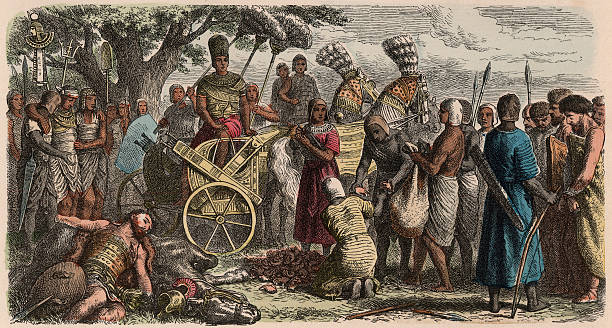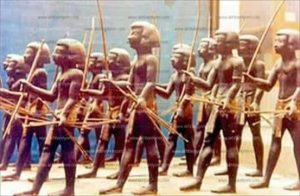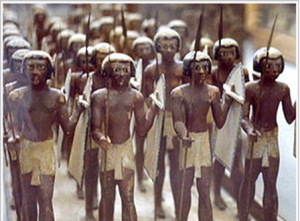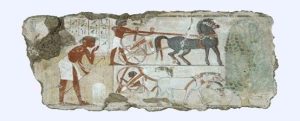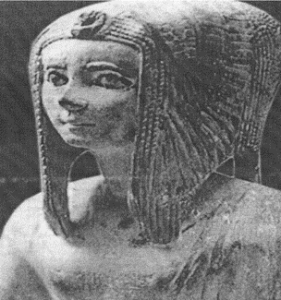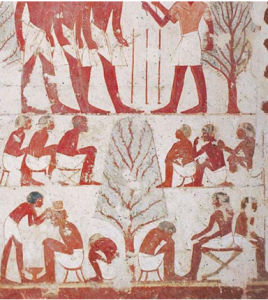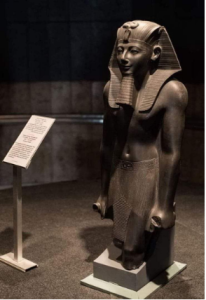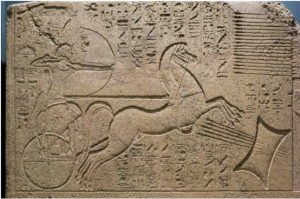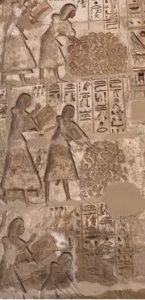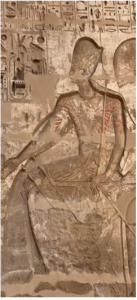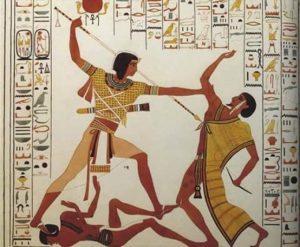The Ancient Egyptian Army
The ancient Egyptian army consisted of several units: •Archers: Soldiers armed with bows and arrows. •Infantry: Foot soldiers equipped with spears and shields. •Chariot Corps: Soldiers who fought from chariots. •Scouts: These soldiers performed reconnaissance, similar to modern intelligence agencies.
Privileges of Military Officers
Military officers enjoyed numerous privileges. They were granted land and livestock as a reward for their service to the pharaoh. Similarly, ordinary soldiers were exempt from taxes. Military scribes, who documented battles, also held important positions and treated the same way. -Grandparents with bow and arrow and greatest grandson (Mo Salah)
A model of ancient Egyptian infantrymen -in the Egyptian Museum.
model for Egyptian soldiers was discovered in the tomb of Mesehti.
Military Administration
The Egyptian military had a highly organized administrative system responsible for supplying the army with weapons, building ships, storing grain, and provisioning fortresses. The army maintained a high level of organization from the early dynastic period until the end of the Old Kingdom.
Military History
Egypt experienced internal conflicts between its provinces in the pre-dynastic period. However, King Narmer unified the two lands and established a powerful army. The army’s primary role was to protect Egypt’s borders. To this end, pharaohs of the Old Kingdom constructed fortresses, particularly in Sinai and the western desert, which was inhabited by nomadic tribes. These fortifications were known as “the Gates of the Kingdom” and remained in use until the end of the Middle Kingdom.
The Hyksos Invasion
During the Middle Kingdom, Egypt became a prosperous agricultural nation and was coveted by its neighbors. Rulers in western Asia began to build powerful armies and, taking advantage of Egypt’s weakened state, invaded. This period is known as the Hyksos rule (the Shepherd Kings). The Hyksos controlled Egypt for 108 years, reaching as far south as Middle Egypt. However, Upper Egypt, especially Thebes, remained under the control of native Egyptian rulers The Hyksos invasion of Egypt was a significant shock to the Egyptians, who were unaccustomed to foreign rule. The kings of Thebes responded by assembling a powerful army composed of Egyptians and Nubians. They made significant advancements in their weaponry, such as designing chariot backs that opened to allow for a quick exit and positioning the charioteer closer to the wheel’s axle to reduce weight and improve the horse’s speed. -A picture showing a soldier with a war wheel
The Liberation War
Queen Teti Sheri, the mother of “Seqenen ra”, and his wife Queen Iahhotep, played crucial roles in encouraging and assisting Seqenen ra in building a strong army. Teti Sheri, of Nubian origin, helped her son enlist Nubian soldiers, who combined with the Egyptian soldiers from Thebes to form a formidable force. Seqenen ra led this army northward, conquering Middle Egypt and eventually reaching Avaris, the Hyksos capital. Although he was killed in battle at a young age at 35 years old, his sons Kamose and Ahmose continued his mission. Kamose also met an untimely death, but Ahmose, at only 18 years old, successfully liberated Egypt from Hyksos rule and pursued them into Palestine, ultimately annihilating them. -Queen Tet Sheri, mother of Seqenen ra, grandmother of Ahmose and Kamos
Queen Iahhotep
Queen Iahhotep, wife of Seqenen ra and mother of Ahmose and Camus
Conscription
Following the expulsion of the Hyksos, the Egyptians realized that defending Egypt required a proactive approach, rather than merely relying on border fortifications. To this end, they established a strong army with the goal of expanding Egypt’s borders to the Euphrates River, preventing future invasions from Asia. This marked the beginning of a conscription system in Egypt during the New Kingdom. A famous depiction from the tomb of “Osarhat” shows soldiers getting their hair cut as part of the conscription process and other solders waiting for their turn. -depiction from the tomb of “Osarhat” shows conscription process
The Egyptian Empire
King Ahmose began to think about securing Egypt’s borders from the outside, so he thought about reaching his borders as far as Mesopotamia, but he died young. His wife, Queen Nefertari encouraged her son, Thutmose I, to continue his father’s work of expanding the empire. Thutmose I successfully extended Egypt’s borders to the Euphrates River and erected a stele commemorating this achievement, stating that these lands were now under Egyptian rule. Military scribes recorded that Egypt’s borders now reached the “inverted river,” referring to the Euphrates, which flows from north to south, unlike the Nile. The Egyptian Empire reached its peak under the reign of Thutmose III, His military strategies are still studied in military academies today. He was a pioneer in the use of surprise tactics, launching swift and unexpected attacks on his enemies, as famously demonstrated in the Battle of Megiddo. His famous quote, “We are the nation that created morality”.
Emperor of the ancient world (Thutmose III)
Ramesses II inside his war chariot
The Decline of the Egyptian Empire
Following the reigns of great pharaohs like Thutmose III, Seti I, and Ramesses II, the Egyptian Empire began to weaken. Its borders shrank, and neighboring peoples became increasingly bold in their attempts to encroach on Egyptian territory. Ramesses III, of the 20th Dynasty, faced significant challenges from the Sea Peoples, who sought to invade Egypt and seize its naval fleet. His famous declaration, “I will cut off the hands of anyone who harms Egypt,” highlights his determination to protect his nation. He was the last strong kings keeping Egypt safe at that time. In the Late Period, following the end of the New Kingdom, Egypt faced multiple invasions by the Persians. The Egyptians sought the aid of Greek mercenaries, strengthening ties between the two nations. Eventually, Alexander the Great conquered Egypt in 332 BC, bringing the era of Egyptian independence to an end. [Image descriptions: Thutmose III, often referred to as the “Napoleon of Egypt”; Ramesses II in his war chariot; a;

